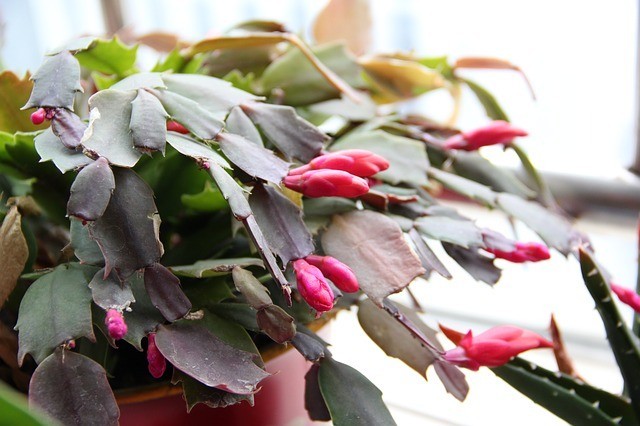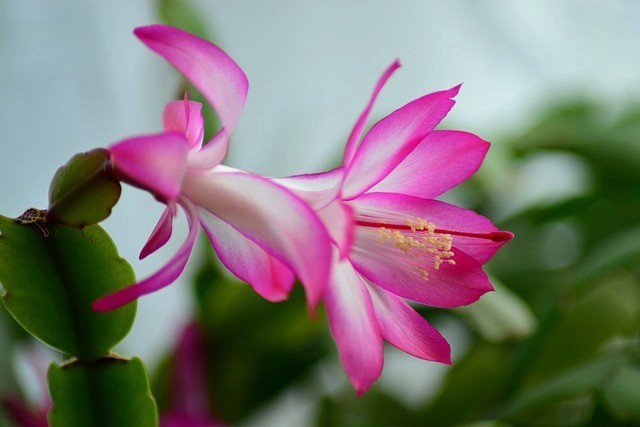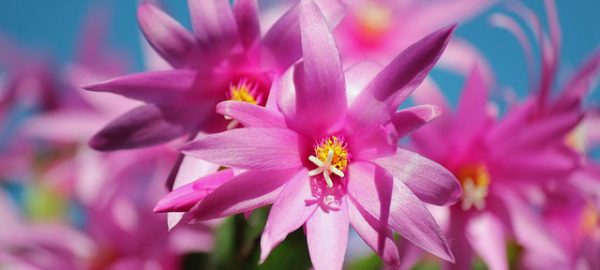Contributing author, Sophia Perry describes how getting a Christmas Cactus to bloom on time can be done by following a few simple steps.
If you’re a big fan of the Christmas Cactus, you probably want to know how to make it bloom just in time for holidays. These succulent plants create beautiful flowers that emerge from their tendrils. The colorful sight in the middle of winter creates a magical atmosphere in your garden. So, the only thing remaining to do is to force it into dormancy. Although this might sound complicated, since it needs to be done eight weeks prior, you just need to time it correctly. If you do so, and start the process in October, your Christmas Cactus will surprise you with beautiful bright-colored flowers, just in time for the holidays. Read on to learn about all the tricks to help your Cactus bloom on time.

What is a Christmas Cactus?
If you have received a Christmas Cactus for the holidays or plan on growing one, you probably want to know more about it. These succulent plants are popular for the fact that they actually thrive in cold temperatures. Additionally, you need to keep these plants away from any kind of heat sources. You’ll see that they do best in a cool environment.
A Christmas Cactus is native to Brazil and its rain forests. So, that is why the plant does best in a humid environment. Moreover, the plant does not pose a threat for family pets since it is non-toxic to both cats and dogs. So, whether you decide to grow your Cactus inside the house or in the garden, you can be sure that the plant is harmless. If you care for it in the right way, expect for it to live up to 3o years. Avoid watering it too much but don’t forget to mist it on a daily basis. Also, beware of the following diseases a Christmas Cactus could catch:
- basal stem rot
- pythium root rot
- botrytis blight
- phytophthora root rot and
- impatiens necrotic spot virus
Possible pest threat
As far as pests are concerned, you can attract a lot of them simply by overwatering your Cactus. You can prevent the pests from spreading onto other plants by discarding the infested ones. That way, you’ll stop the flower thrips or fungus gnats, the most common types of pests, from destroying the healthy plants. Lastly, give your Christmas Cactus a much-needed beauty sleep by putting it in a dark room if kept it inside the house. This will help it bloom since the plant needs more than 14 hours of continuous darkness in order to bloom.
Step 1: don’t water too much
If you avoid watering your Christmas Cactus too often, you are one step closer to the blooms. When the soil receives too much water, it can cause the plant’s health to deteriorate. One of the first symptoms you’ll notice are limp leaves which will eventually start to fall off. In cases that are much more severe, the whole root may start to rot, manifested with a smell.

In order to avoid overwatering, place a soil meter or water the plant only when you notice dryness. If you have already watered your Christmas Cactus too much, act fast by dumping out all the excess water and remove the plant carefully from the container. In case you need more tips and advice from experienced gardeners, visit gardeningonadime.com
Step 2: reduce the light your Christmas Cactus receives
If you really want to make sure that all the odds are in your favor, provide a dark place for your plant. Although plants need light to grow, a Christmas Cactus will have the best chances of blooming in a dark room. Namely, you’ll need to leave it in darkness for approximately 12 to 14 hours a day. Similarly, avoid artificial lights by turning them off at night if you’re keeping your Cactus in a room. As far as the rest of the day goes, it is alright to put your cactus in bright but indirect light. With this combination of light and dark, your Cactus will have the best chances of blooming.

Step 3: reduce the temperature in the environment
Finally, keeping your Christmas Cactus cool is crucial when it comes to its possible blooming. The average temperature that this plant enjoys ranges from 50 to 55 degrees F throughout the day. Although the plant likes to be warm, avoid putting it in direct contact and close to a fireplace or similar heat sources.
There are cases when a Christmas Cactus suffered a lot of damage because it was exposed to freezing cold. Treating a damaged Cactus requires a lot of patience and dedication. You would need to remove all the badly-damaged tissue and water the plant lightly. Hopefully, your Christmas Cactus will be just fine when you follow these tips.
A Christmas Cactus is a shy bloomer
To conclude, don’t get discouraged if your Cactus does not always bloom when you follow these steps. Since they are shy bloomers, even when meeting their needs, you might be left without any flowers in the end. You should provide them with extra care and patience in order to get them to bloom on time. So, as mentioned earlier, avoid water damage by reducing watering and mist your Christmas Cactus daily. Put them in a place that gives them enough darkness throughout the day and don’t turn on any artificial lights. Finally, get the temperature adjusted and don’t let your plant freeze. Approximately, your Cactus will enjoy the temperature around 55 degrees F. If you manage to satisfy your plant’s needs, you won’t have to deal with all kinds of damage caused by improper handling.
Author Bio
Contributing author, Sophia Perry works as a writer and agent for Triple 7 Movers Las Vegas. She has a green thumb and loves spending time outdoors. When she’s not working in her vegetable garden or trying out organic recipes, she likes to go camping with her family.
